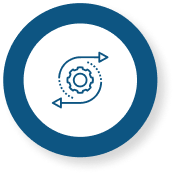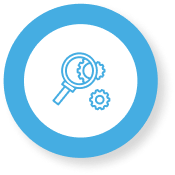Every click, transaction, social media interaction, and sensor reading generates a colossal amount of information. For a moment, consider the magnitude of data created each day by your customers, employees, supply chains, marketing efforts, and more. The data comes in diverse forms from various sources. This is the essence of big data.
Organizations today have recognized the immense potential locked within big data. However, it’s not just about accumulating vast volumes of data; it’s about unlocking its hidden insights. Thanks to rapidly evolving technology, Big Data Analytics has emerged as the key to transforming terabytes of information into actionable knowledge.
This blog will guide you through the world of big data analytics, from its historical roots to its pivotal role in today’s digital landscape.

Here’s What You Will Learn in This Blog
- Why ERP Integration Matters?
- The Baffling World of Data Production
- Why Big Data Analytics Matters
- How Big Data Analytics Works
- Benefits of Big Data Analytics
- Real-World Applications
- Big Data Analytics Technologies and Tools
- Nsight: Your Partner in Big Data and Analytics for Business Transformation
- Frequently Asked Questions (FAQs)
Why ERP Integration Matters?
Big data analytics is the comprehensive process of collecting, processing, and deriving insights from extensive, high-velocity, high-volume data sets. These datasets originate from many sources, including the web, mobile devices, email, social media, and networked smart devices. What makes big data unique is its rapid generation and the myriad of formats it encompasses, spanning structured data like database tables and Excel sheets, semi-structured content including XML files and webpages, as well as unstructured elements like images and audio files.
Traditional data analysis tools must be equipped to handle the complexity and scale of big data. This is where specialized systems, tools, and applications for big data analysis come into play. Data sources are growing increasingly intricate due to the influence of artificial intelligence, mobile devices, social media, and the Internet of Things (IoT). For instance, data types can range from sensor data and video/audio to network logs, transactional records, and social media updates. Much of this data is generated in real-time and at an enormous scale. Big data analytics is a sophisticated process that involves scrutinizing big data to unveil concealed patterns, correlations, market trends, and customer preferences. It empowers organizations to make informed, data-driven decisions. At its core, data analytics technologies provide a way to dissect data sets and uncover novel insights, answering questions about business operations and performance.
The Baffling World of Data Production
It’s staggering to contemplate the sheer volume of data generated daily. To appreciate the significance of big data analytics, we must explore its history and growth.
The term “big data” was coined in the mid-1990s to describe the exponential growth in data volumes. However, it wasn’t until 2001 that Doug Laney, an analyst at Meta Group Inc., expanded the concept to encompass the “3Vs”: Volume, Variety, and Velocity.
• Volume represents the sheer scale of data, rapidly increasing and overwhelming traditional storage and processing methods.
• Variety acknowledges that data comes in various forms, including structured, semi-structured, and unstructured data.
• Velocity highlights the speed at which data is generated, especially with real-time data streams.
Gartner embraced this 3V framework after acquiring Meta Group in 2005, propelling big data into the limelight. The launch of the Hadoop distributed processing framework in 2006 was another turning point. This open-source platform laid the foundation for managing and processing large-scale data on clustered systems, driving the growth of big data analytics.
By 2011, big data analytics had firmly established its presence in the tech landscape. It was initially embraced by internet giants like Yahoo, Google, and Facebook, along with analytics and marketing service providers. In recent years, big data analytics has evolved into a fundamental technology driving digital transformation across various industries, including retail, finance, manufacturing and big data analytics in healthcare.
Big data analytics has grown from an abstract concept to a fundamental component of today’s data-driven world. Its applications are as diverse as the data sources it taps into, and its potential continues to expand as technology advances.

Why Big Data Analytics Matters
Now that we’ve delved into what big data analytics is, it’s essential to understand why it holds such immense importance in the modern world. The application of big data analytics is a transformative force for organizations, offering them the ability to make data-driven decisions that can yield significant improvements in various aspects of their operations. Here’s why big data analytics is crucial:
• Enhanced Decision-Making: Big data analytics empowers organizations to make more informed decisions. By leveraging massive volumes of data, businesses can get deeper insights into customers, operations, and market trends. This leads to better decision-making, which can have a profound impact on business-related outcomes.
• Competitive Advantage: With an effective big data analytics strategy, organizations can gain a competitive edge over their rivals. The insights obtained through data analysis can lead to more effective marketing, new revenue opportunities, customer personalization, and improved operational efficiency. These advantages can help businesses outperform their competitors.
• Utilizing Data for Value: With the ubiquity of social media, and the expansive network of the Internet of Things (IoT), organizations possess vast information that can be leveraged to enhance their operations, strategic thinking, and the value they provide to their customers. Big data analytics tools and applications are essential in helping organizations gain insights, optimize their processes, and predict future outcomes.
• Holistic Decision-Making: Big data analytics encourages a holistic, data-driven approach to decision-making. Whether it’s a retailer refining targeted ad campaigns, a wholesaler streamlining supply chains, or a healthcare provider discovering new clinical care options, big data analytics unlocks new dimensions of understanding. This approach promotes growth, efficiency, and innovation.
With the understanding of why big data analytics is so crucial, let’s explore how it operates.
How Big Data Analytics Works
Big data analytics is a complex yet highly effective process that involves examining extensive datasets to uncover valuable insights. To successfully analyze the data, it goes through a comprehensive, step-by-step preparation process, which can be summarized as follows:
Gather
Gather
Big data is collected in its diverse forms, including structured, semi-structured, and unstructured data, originating from various sources spanning the web, mobile devices, and the cloud. It is then stored in repositories such as data lakes or data warehouses in preparation for processing.
Process
Process
During this phase, the collected data is verified, sorted, and filtered to prepare it for further analysis. This process enhances the performance of data queries and other analysis.
Analyze
Analyze
With the data now prepared, the actual analysis can commence. Big data analytics relies on various tools and technologies, including data mining, artificial intelligence (AI), predictive analytics, machine learning, and statistical analysis. These techniques help to identify, define, and predict patterns and behaviors within the data.
Cleanse
Cleanse
Following the processing phase, the data undergoes thorough cleansing to guarantee accuracy and purity. Any conflicts, redundancies, invalid or incomplete fields, and formatting errors are rectified and purged from the dataset.

Gather
Big data is collected in its diverse forms, including structured, semi-structured, and unstructured data, originating from various sources spanning the web, mobile devices, and the cloud. It is then stored in repositories such as data lakes or data warehouses in preparation for processing.

Process
During this phase, the collected data is verified, sorted, and filtered to prepare it for further analysis. This process enhances the performance of data queries and other analysis.

Cleanse
Following the processing phase, the data undergoes thorough cleansing to guarantee accuracy and purity. Any conflicts, redundancies, invalid or incomplete fields, and formatting errors are rectified and purged from the dataset.

Analyze
With the data now prepared, the actual analysis can commence. Big data analytics relies on various tools and technologies, including data mining, artificial intelligence (AI), predictive analytics, machine learning, and statistical analysis. These techniques help to identify, define, and predict patterns and behaviors within the data.
Benefits of Big Data Analytics
The application of big data analytics offers a wide array of benefits to organizations, including:
- Swift and Informed Decision-Making: Big data analytics equips businesses to swiftly access and analyze extensive datasets from a multitude of sources. This capability not only yields fresh insights but also facilitates rapid, data-driven decision-making.
- Cost Savings and Enhanced Operational Efficiency: Adaptable data processing and storage tools contribute to cost savings in managing large data quantities. Furthermore, these tools expedite the identification of patterns and valuable insights, optimizing operations and ultimately boosting efficiency.
- Data-Driven Go-to-Market Strategies: Analyzing data from various sources, including sensors, devices, social media, and the web, allows organizations to adopt a data-driven approach. This helps in understanding customer needs, identifying potential risks, and creating new products and services.
Breaking it Down
Real-World Applications
Big data analytics finds applications in various sectors and industries, helping organizations make informed decisions when it comes to product strategy, sales, operations, marketing, and customer care. Here are a few big data analytics examples:
1. Product Development: Organizations can leverage big data analytics to understand customer needs through extensive business analytics data. This insight guides feature development and roadmap strategy.
2. Personalization: Streaming platforms and online retailers use big data analytics to analyze user engagement and create personalized experiences through recommendations, targeted ads, upsells, and loyalty programs.
3. Supply Chain Management: Predictive analytics helps forecast and optimize every aspect of the supply chain, including inventory, procurement, delivery, and returns.
4. Healthcare: In the healthcare sector, big data analytics is employed to glean insights from patient data, leading to the discovery of new diagnoses and treatment options.
5. Pricing Strategies: Sales and transaction data can be analyzed to create optimized pricing models, allowing companies to maximize revenue.
6. Fraud Prevention: Financial institutions rely on data mining and machine learning to detect and predict patterns of fraudulent activity.
7. Operational Efficiency: Analyzing financial data helps organizations detect and reduce hidden operational costs, saving money and increasing productivity.
8. Customer Acquisition and Retention: Online retailers use data analysis to predict customer behavior, facilitating better retention strategies.
These are just a few examples of how big data analytics transforms various industries. The potential applications are nearly limitless, allowing organizations to harness the power of data to make more informed, strategic decisions and drive innovation.
Big Data Analytics Technologies and Tools
Many big data analytics software technologies and tools play pivotal roles in enabling organizations to extract valuable insights from massive datasets. Here are some of the key technologies and tools for big data analytics that are commonly used in organizations:
• Hadoop: It is an open-source framework for storing and processing large and diverse datasets. It excels in handling structured and unstructured data and is a fundamental component of many big data analytics architectures.
• Predictive Analytics Hardware and Software: Predictive analytics involves processing complex data using machine learning and statistical algorithms to predict future events. Organizations leverage predictive analytics tools for applications such as fraud detection, marketing, risk assessment, and operations optimization.
• Stream Analytics Tools: Stream analytics tools filter, aggregate, and analyze real-time or near-real-time data that may originate from various formats or platforms. They enable organizations to gain insights from constantly evolving data streams.
• Distributed Storage Data: Distributed storage ensures data is replicated across nodes, typically in a non-relational database. This redundancy safeguards against node failures, data loss, or corruption and provides low-latency data access.
• NoSQL Databases: Non-relational data management systems like NoSQL databases are invaluable when working with vast sets of distributed data. They do not require fixed schemas, making them ideal for managing raw and unstructured data.
• Data Lake: As a large storage repository, data lake houses raw data in its native format until needed. It uses a flat architecture, providing flexibility and scalability.
• Data Warehouse: Data warehouses are repositories that store extensive datasets collected from diverse sources. They typically employ predefined schemas for data organization.
• Knowledge Discovery/Big Data Mining Tools: These tools enable businesses to mine structured and unstructured big data, extracting valuable knowledge and patterns.
• In-Memory Data Fabric: In-memory data fabric distributes data across system memory resources, facilitating low-latency data access and processing.
• Data Virtualization: Data virtualization allows data access without technical constraints, enabling seamless integration across various platforms.
• Data Integration Software: Data integration software streamlines the movement of big data across different platforms, including Apache, Hadoop, MongoDB, and Amazon EMR.
• Data Quality Software: Data quality software is crucial in cleansing and enriching large datasets, ensuring data accuracy and integrity.
• Data Preprocessing Software: This software prepares data for further analysis by formatting and cleansing unstructured data.
• Spark: As an open-source cluster computing framework, it is widely used for batch and stream data processing. It provides real-time data processing capabilities.
Big data analytics applications frequently integrate data from both internal systems and external origins, including sources like weather data or demographic information obtained from third-party providers. Moreover, real-time streaming analytics applications are becoming increasingly prevalent in big data environments, enabling users to perform analytics on data fed into systems via stream processing engines like Spark, Flink, and Storm.
Traditionally, big data systems were deployed on-premises, especially in large organizations dealing with massive data. However, cloud platform vendors like Amazon Web Services (AWS), Google, and Microsoft have simplified the setup and management of Hadoop clusters in the cloud. Suppliers like Cloudera also support the distribution of Hadoop on these cloud platforms. This shift to the cloud enables users to create and manage clusters as needed, with usage-based pricing that eliminates the requirement for ongoing software licenses. It offers greater flexibility and scalability for big data analytics projects.
Big data has increasingly become a valuable asset in supply chain analytics. Big supply chain analytics harnesses the power of vast datasets and quantitative techniques to optimize decision-making processes throughout the supply chain. This approach extends beyond the confines of traditional internal data housed in enterprise resource planning (ERP) and supply chain management (SCM) systems. In addition, big supply chain analytics leverages highly effective statistical methods on both existing and new data sources.
Nsight: Your Partner in Big Data and Analytics for Business Transformation
In the complex and demanding landscape of today’s business world, companies must analyze and synthesize data, transforming it into actionable insights. With the aid of Big Data tools, business leaders gain the confidence to use analytics to solve their challenges, making well-informed decisions. Our team collaborates closely with clients to manage risks, enhance business performance, drive profitable growth, and equip businesses with the insights to lead the next wave of disruption and innovation.
Nsight offers a comprehensive suite of Big Data Analytics Services encompassing various domains, including business, operations, marketing, and sales analytics. Our team facilitates advanced visualizations to empower decision-makers through big data solutions to accelerate their business’s value.
We offer big data analytics consulting and help businesses implement effective practices to lay the foundation for sustained business growth. With deep expertise in Big Data and Analytics, we deliver the desired business outcomes tailored to the unique demands of each client’s industry and business, all within the specified timeline.
Frequently Asked Questions (FAQs)
In today’s data-driven world, an overwhelming amount of data is generated at an unprecedented rate. Big data analytics has become as a vital tool that empowers organizations spanning various industries to harness this data deluge. It enables them to extract valuable insights, optimize operations, and predict future outcomes, ultimately fostering growth.
Big data analytics and cloud computing are not distinct and separate concepts; instead, they complement each other effectively. The storage, processing, and analysis of large data volumes demand robust computing resources and a scalable infrastructure. Cloud computing provides the necessary help with on-demand availability, facilitating the storage and processing of data in the cloud on a substantial scale.
The learning outcomes of big data analytics vary depending on your specific role. If you are a data analyst, your education in this field equips you to conduct advanced analytics on a large scale, construct data models, and contribute to data governance. On the other hand, if you are a data scientist, your training encompasses the creation and management of workload environments, the development of machine learning models, and the deployment of machine learning solutions.
The blog touches on various industries using big data analytics for informed decision-making. Can you offer specific real-life examples of how organizations in different sectors, such as retail, finance, and manufacturing, successfully apply big data analytics to drive innovation and growth?
About the Author

Deepak Agarwal, a digital and AI transformation expert with over 16 years of experience, is dedicated to assisting clients from various industries in realizing their business goals through digital innovation. He has a deep understanding of the unique challenges and opportunities, and he is passionate about using cutting-edge technologies to solve real-world business problems. He has a proven track record of success in helping clients improve operations, increase efficiency, and reduce costs through emerging technologies.





